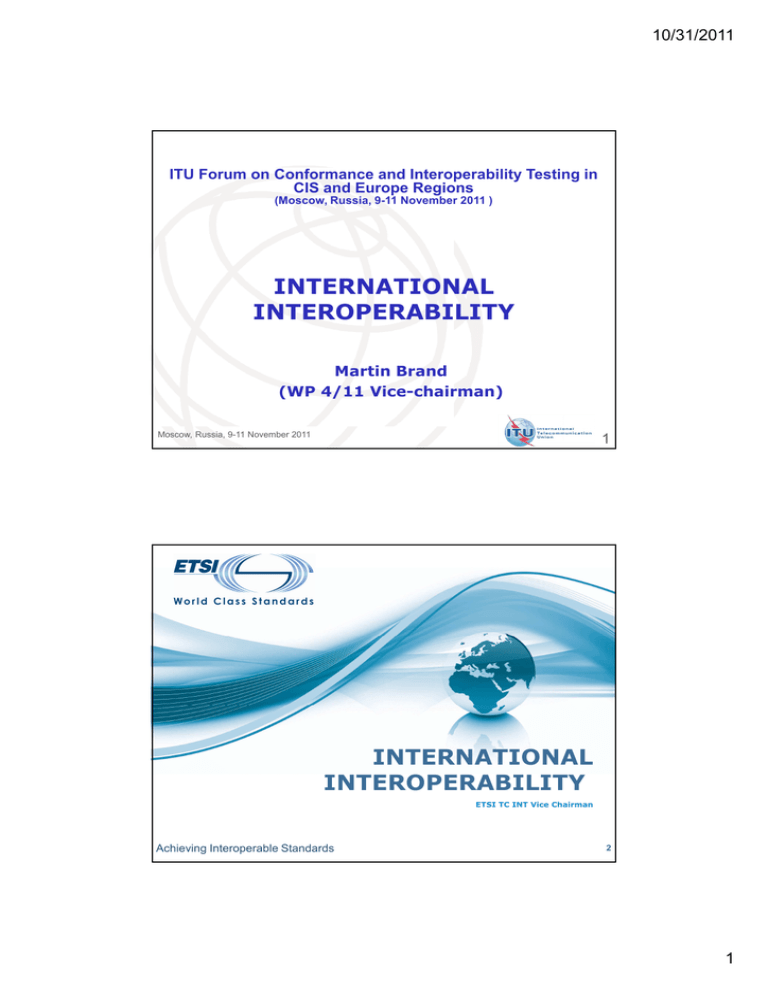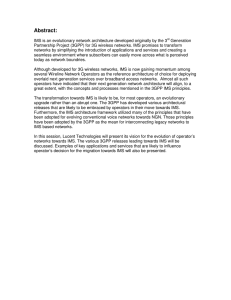INTERNATIONAL INTEROPERABILITY 10/31/2011 1
advertisement

10/31/2011
ITU Forum on Conformance and Interoperability Testing in
CIS and Europe Regions
(Moscow, Russia, 9-11 November 2011 )
INTERNATIONAL
INTEROPERABILITY
Martin Brand
(WP 4/11 Vice-chairman)
Moscow, Russia, 9-11 November 2011
1
INTERNATIONAL
INTEROPERABILITY
ETSI TC INT Vice Chairman
Achieving Interoperable Standards
2
1
10/31/2011
Different ‘Levels’ of Interoperability
No single definition of Interoperability
– The ability of two or more systems or components to
exchange and use information
– ...
Achieving Interoperable Standards
3
IOP and Complex Standards
• Complex ICT (Information and
communications technology) standards are
increasingly specified by ‘islands of standards’
– From different standardisation bodies
– Or developed for a different (original) use
– Complete system not specified in detail
• Results in potentially non-interoperable
standards and/or products
Achieving Interoperable Standards
4
2
10/31/2011
IMS Architecture
•
•
•
•
3GPP Approach
TISPAN Approach
IPX Approach
OMA Approach
Achieving Interoperable Standards
5
3GPP Approach (1)
• IMS was designed as a subsystem that enables delivery of
multimedia services to mobile 3G
• The architecture grew more complicated as the scope of IMS
expanded
• SCCP transmission is possible only over SIGTRAN
• SIGTRAN transmission via IPX networks which are defined by
GSMA, lead to redundancy problems
• The interconnection with other non-3GPP networks is only
possible over SIP-I
• ITU-T NNI profile is not compatible with the 3GPP IMS NNI
profile
• ITU-T and 3GPP are using a different recourse management
subsystems (RACS {3GPP} and RACF {ITU-T})
• ITU-T and 3GPP are using a different IOP packetisation times
• ITU-T SG11 has not specified NGN services, only SIP profiles
Achieving Interoperable Standards
6
3
10/31/2011
3GPP Approach (2)
IP Multimedia Networks
Mb
Mb
Mm Ma
CS
Mk
Le
AS
I-CSCF
BGCF
CS
LCS
Client
Legacy mobile
signalling Networks
CS Network
Sh
Mg
LRF
C, D,
Gc, Gr
Cx
Mk
Mw
Mi
IMSMGW
Cx
Dx
MGCF
Mg
Mn
S-CSCF
Dh
ISC
MRB
Mw
Cr
Ml
SLF
Dx
Mr
Mb
Mm
HSS
BGCF
Mj
E-CSCF
Rc
ISC
Mw
MRFP
MRFC
EATF
Mx
Mb
Mb
Mx
Mx
Rx
Mb
IBCF
Gm
Mi
I4
P-CSCF
Mp
BGCF
Mx
Ici, Mm
Ix
TrGW
UE
Izi
Ut
Achieving Interoperable Standards
7
IMS interconnect scenario without I-BGF
Originating Home Net work
Originating Visit ed Net work
Core IMS (visited)
P-CSCF
Core IMS (home)
IBCF
IBCF
Mx
Ici
S-CSCF
To/from
t erminating
home netw ork
Mx
RACS
Media Flow s
C-BGF
Access Transport
Network
Achieving Interoperable Standards
Core Transport Netw orks
8
4
10/31/2011
IMS interconnect scenario with I-BGF
Originat ing Home Net work
Originat ing Visit ed Net work
IMS (visit ed)
IMS (home)
P-CSCF
IBCF
Mx
RACS
S-CSCF
IBCF
To/from
t erminating
home net work
Mx
Ici
RACS
Media Flows
I-BGF
C-BGF
Access Transport
Network
Core Transport Net works
Achieving Interoperable Standards
9
Interworking with non IMS multimedia
networks
Core IMS
P-CSCF
S-CSCF
Mw
IBCF
Mx
H.323 network
Or
Ot her non-IMS SIP
network
IWF
Ib
Iw
Domains boundary
Achieving Interoperable Standards
10
5
10/31/2011
Interconnection Interfaces
24.229 Mx Interface
24.229 Mx Interface
24.229 Mx Interface
TISPAN Approach
• TISPAN is an ETSI Group which defines IP standards for NGN
and migration from fixed line networks
• TISPAN did not set out to reinvent another type of core IMS,
but adopted whatever possible from the 3GPP specifications
• It specifies two principal types: analog fixed phones
interfaces and IP terminals with advanced multimedia
capabilities. These types of terminal require two types of
feature management: Emulation and Simulation
• The IOP with other non-3GPP NGN networks (e.g. ITU-T
NGN) is only possible over SIP-I
• The IOP with other 3GGP based NGN networks is only
possible if the XML MIME schema for PSTN is supported
• ITU-T NNI profile is not compatible with the 3GPP IMS NNI
profile
Achieving Interoperable Standards
12
6
10/31/2011
TISPAN Approach
Achieving Interoperable Standards
13
PSTN/ISDN emulation
subsystem - functional architecture
Application Servers
Ut
Rf/Ro
Rf/Ro
Other types of service logic
Ut
Charging
Funct ions
PSTN/ISDN Emulation logic
Network
Attachment
Subsystem
Sh
UPSF
Dh
Dx
Iw
SLF
Ib
P3
e2
IWF
IMS-based PES
Mw
e2
P1
Rf/Ro
ISC/Ma
Cx
Mw/Mk/Mm
I/S-CSCF
AGCF
Mw
BGCF
MGCF
Mp
Mn
Ie
Gq'
Ut
Resource and Admission Cont rol Subsyst em
SGF
Other IP Networks
Mg
MRFC
PSTN/ISDN
Gq'
Gq'
Mj
Mw
P-CSCF
Ic
Mk
Mr
Mw
Gm
IBCF
Mk
Mi
VGW
MRFP
Z
T-MGF
IP Transport (Access and Core)
Z
I-BGF
MG
Achieving Interoperable Standards
14
7
10/31/2011
NGN, NGMN
Achieving Interoperable Standards
15
The OMA approach
•
The OMA (open mobile Alliance)
concentrates on service delivery capability,
rather than session admission and session
control. OMA recognize IMS Type of
services and non-IMS services (Web
services, data centric services, near real
services or M2M services)
• The IOP depends from the 3GPP IOP
signaling and QoS requirements
Achieving Interoperable Standards
16
8
10/31/2011
IPX
• IPX is a multiservice, converged, global
interconnection model designed by the GSMA to
carry existing services as well as next generation
services. It offers the benefits of IP, while adding
controlled Quality of Service (QoS), security,
cascading session-based billing and multilateral
interconnection possibilities
• The IOP is limited on transmission mobile
applications and the transmission of SIP-I, SIP and
Diameter.
• The QoS is based on 3GPP TS 23.107 which have
defined 4 different „QoS Types‟ or „Traffic Classes‟
but without recourse management
Achieving Interoperable Standards
17
IPX end-to-end responsibility
Achieving Interoperable Standards
18
9
10/31/2011
Conclusion
• The ITU-T NGN can be interconnected with
IMS networks only with SIP-I and with
SIGTRAN due to profile mismatches
• The SIP UNI and SIP NNI Profiles and
resource management are not compatible
• ITU-T has no defined services and the endto-end functionality is not ensured.
• The end user is buying services not
protocols – quality of experience
• As no ITU-T services are defined no
interconnection tests can by standardized
Achieving Interoperable Standards
19
THANK YOU!
Martin Brand
martin.brand@A1telekom.at
10

